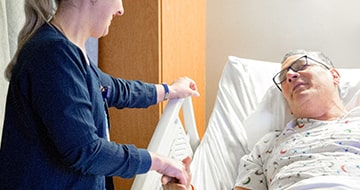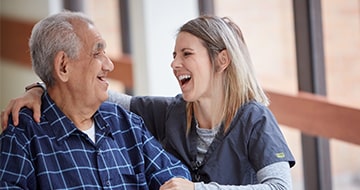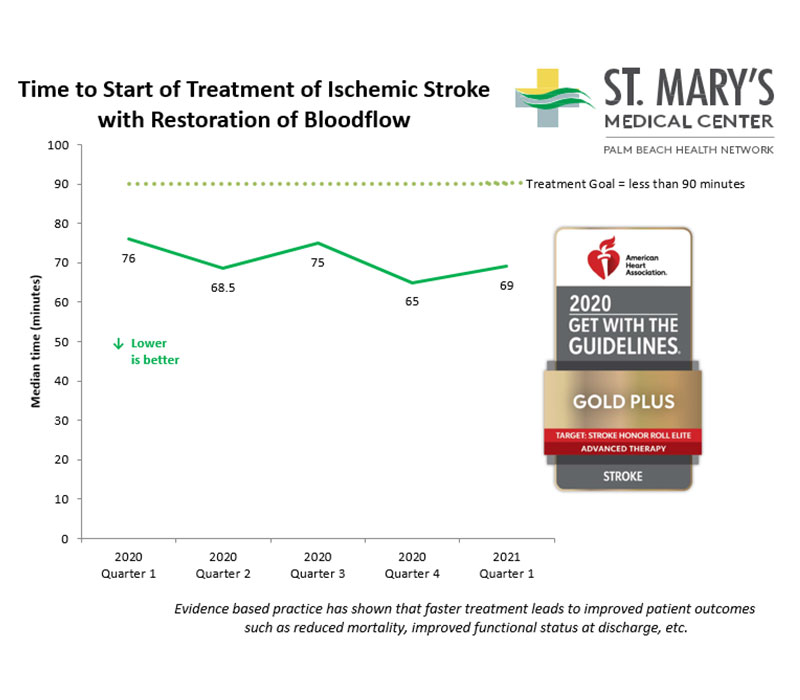Comprehensive Stroke Center
St. Mary’s Medical Center is an award-winning Comprehensive Stroke Center providing quality care in stroke prevention, stroke management, and stroke rehabilitation. Every 40 seconds in the United States someone has a stroke, making it the fifth
leading cause of death among adults. Our center is equipped with some of the latest diagnostic and therapeutic advances to quickly and accurately diagnose and treat stroke patients. Patients benefit from a range of comprehensive medical, surgical
and minimally invasive treatment options, as well as access to clinical trials and research.
Our multidisciplinary team of physicians and specialists includes emergency medicine physicians, neurohospitalists, vascular neurosurgeons, interventional neurologists, neuroradiologists, intensivists, rehabilitation specialists and nurses with advanced
training. Upon arrival, the team works together to provide every patient with a comprehensive evaluation and collaborative management.
St. Mary’s Medical Center is a GE Show site
The team at St. Mary’s Medical Center understands that time is critical when treating stroke patients. When a stroke strikes, 1.9 million neurons are lost per minute. Every minute without care, the brain ages three weeks. With the importance of
time, having a stroke center with the technology and capability to care for you can make all of the difference.
Given the success of the comprehensive stroke program at St. Mary’s, they were the first hospital in the nation to become a national show site for advanced interventional technology through GE. While they are no longer the only show site in the
nation, they continue to allow other comprehensive centers to visit their center and learn from their program, while still continuing to offer the latest in technology in stroke care for the community. The stroke program is supported by a multidisciplinary
team of specialists, trained to ensure that the appropriate level care is provided to stroke patients within the community and the surrounding areas.
What is Stroke?
A stroke is an emergency requiring immediate medical attention. Strokes happen when blood flow to the brain is interrupted, causing brain cells to begin dying from lack of oxygenated blood.
There are two major kinds of stroke:
- Ischemic Stroke -The most common, is caused by a blood clot that blocks or plugs a blood vessel or artery in the brain. This clot causes a region of the brain to be deprived of oxygen and essential nutrients, leading
to death of brain cells.
- Hemorrhagic Stroke – This type of stroke is caused by a blood vessel breaking and bleeding into the brain. Two types of weakened blood vessels that typically cause hemorrhagic stroke are aneurysms and arteriovenous
malformations (AVMs).
- Brain Aneurysms- A brain aneurysm occurs when a blood vessel develops a weak area in the wall that allows the vessel to balloon out and fill with blood.
- Arteriovenous malformations (AVMs) - AVMs happen when a group of blood vessels in your body forms incorrectly. In these malformations, arteries and veins are unusually tangled.
Stroke Signs and Symptoms
- A sudden, severe headache
- Seizures
- Loss of sensation in part of the body
- Muscle weakness
- Changes in vision
- Facial paralysis
- Drooping eyelids
- Problems speaking
- Changes in a sense of smell
- Problems with motion
- Dizziness
- Loss of consciousness

If you experience any of the stroke signs, or identify the signs in someone else, B.E. F.A.S.T. and dial 911. Use the National Stroke Association’s B.E. F.A.S.T. test to help you remember the warning signs and symptoms of stroke:
- Balance - Balance loss – Check to see if the person has trouble walking or standing up right
- Eyesight - Eyesight loss – Is the person experiencing loss of eyesight?
- Face - Facial weakness – Ask the person to smile. Does one side of the face droop?
- Arms - Arm weakness – Ask the person to raise both arms. Does one arm drift downward?
- Speech - Speech problems – Ask the person to repeat a simple sentence. Are the words slurred? Can the patient repeat the sentence correctly?
- Time - If a person is having trouble with these basic commands, call 911 immediately.
B.E. F.A.S.T. to help you remember the signs.
Treating Stroke
Strokes are fast. We’re faster. At St. Mary’s Medical Center, we treat strokes as a medical emergency. Once a “code stroke” is called our stroke team is activated and ready to provide our patients with rapid treatment. Most strokes are caused by blood clots plugging a blood vessel or artery in the brain. This type of stroke may be treated with a clot busting medication. This type of medication has been found to be most effective when administered within three hours of symptom onset. Time is extremely important when stopping a stroke in progress and minimizing the potential damage.








